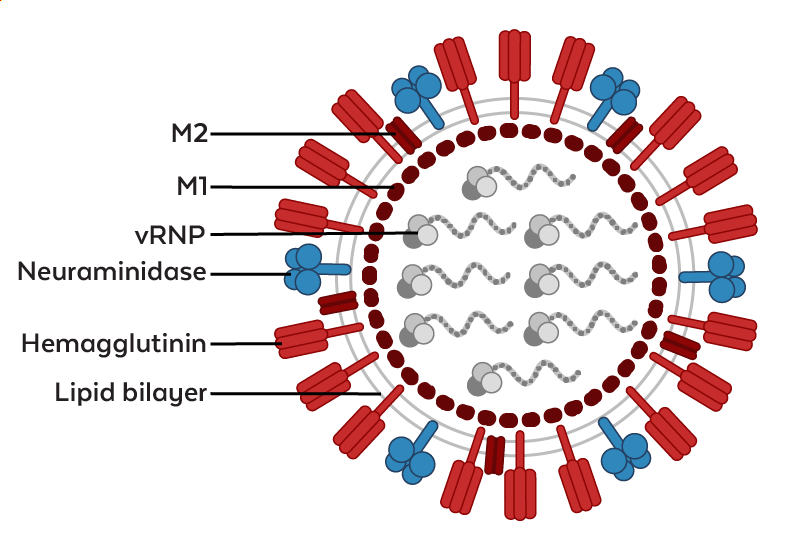Recent developments in the spread of the H5N1 avian influenza (commonly known as bird flu) virus have raised global concerns, marking a significant shift in the virus's epidemiology. Initially identified over two decades ago, H5N1, a strain of highly pathogenic avian influenza (HPAI), has undergone substantial genetic changes, enhancing its pathogenicity and expanding its host range. Notably, the virus has demonstrated the capability to infect a wide array of avian species and mammals, including humans, posing a potential risk of a future pandemic.1
In light of these developments, research efforts have intensified to understand the molecular mechanisms of H5N1 pathogenicity and transmissibility. A critical area of focus is the hemagglutinin (HA) protein, a major surface antigen of the influenza virus that mediates entry into host cells. Rockland's advanced suite of antibodies against the H5N1 HA protein offers a vital tool for scientists aiming to map the antigenic landscape of H5N1 and develop strategies for both therapeutic interventions and vaccines.

Figure. Schematic representation of an influenza A virus (Adapted from Eichberg et al., 2022)
H5N1 Antibody Cross-Reactivities
| HA Clade | H5N1 Influenza Virus | HI titers with anti-HA monoclonal antibodies | |||||
| VN04-2 | VN04-8 | VN04-9 | VN04-10 | VN04-13 | VN04-16 | ||
| H5 Ref. | A/tern/South Africa/1961 | 100 | < | < | < | < | < |
| North American | A/chicken/Pennsylvania/1370/1983 | 3200 | < | 25600 | 200 | 3200 | < |
| A/mallard/Pennsylvania/10218/1984 | 800 | < | 200 | 6400 | 25600 | 400 | |
| A/chicken/Hidalgo/28159-232/1994 | < | < | 200 | 100 | 1600 | < | |
| A/mallard/Arkansas/1/2001 | 1600 | < | 200 | 400 | 3200 | 100 | |
| Clade 0 | A/Hong Kong/156/1997 | 6400 | < | 25600 | 6400 | 25600 | 400 |
| A/Hong Kong/481/1997 | 6400 | < | 1600 | 1600 | 12800 | 100 | |
| A/duck/Singapore/3/1997 | 200 | < | 200 | 800 | 6400 | 200 | |
| A/goose/Hong Kong/437-4/1999 | 6400 | < | 6400 | 1600 | 6400 | 200 | |
| Clade 1 | A/Vietnam/1194/2004 | 3200 | 1600 | 12800 | 3200 | 6400 | 1600 |
| A/Vietnam/1203/2004 | 6400 | 1600 | 12800 | 3200 | 6400 | 1600 | |
| A/Vietnam/HN30408/2005 | 6400 | 3200 | 3200 | 3200 | 6400 | 1600 | |
| A/Hong Kong/213/2003 | 6400 | 3200 | 400 | 3200 | 800 | 3200 | |
| Clade 2.1.2 | A/Indonesia/6/2005 | 3200 | < | 800 | 25600 | 200 | 6400 |
| Clade 2.1.3 | A/Indonesia/5/2005 | < | < | 400 | 12800 | 200 | 3200 |
| A/chicken/Indonesia/PA03/2003 | 800 | 3200 | 200 | 3200 | 1600 | 1600 | |
| A/duck/HUNWG/1504/2004 | 1600 | < | 3200 | 1600 | < | 400 | |
| A/duck/GXLA/1304/2004 | < | 1600 | < | 3200 | 1600 | 1600 | |
| A/chicken/Jogjakarta/BBVET/IX/2004 | 100 | < | 100 | 3200 | 3200 | 400 | |
| A/chicken/Malang/BBVET/IV/2004 | 3200 | 3200 | < | 3200 | 3200 | 1600 | |
| Clade 2.2 | A/whopper swan/Mongolia/244/2005 | < | 1600 | < | 3200 | 1600 | 1600 |
| A/turkey/15/2006 | 100 | < | < | 3200 | < | 400 | |
| A/bar headed goose/Qinghai/1A/2005 | 100 | 6400 | < | 6400 | 12800 | 3200 | |
| Clade 2.3.4 | A/duck/Hunan/15/2004 | 1600 | < | 3200 | 1600 | < | 400 |
| A/duck/Laos/3295/2006 | < | < | 400 | 1600 | 100 | 100 | |
| A/chicken/Malaysia/935/2006 | 100 | < | 400 | 800 | 100 | 100 | |
| A/common magpie/Hong Kong/645/2006 | < | < | 200 | 400 | < | 100 | |
| Clade 2.4 | A/duck/Guangxi/13/2004 | < | 1600 | < | 3200 | 1600 | 1600 |
Table 1: Hemagglutination inhibition (HI) testing was performed with 0.5% chicken red blood cells by a standard method.3 (<) less than 1:100.
H5N1 Antibodies
| Product | Clonality | Clone | Size |
| H5N1 Antibody VN04-2 | Monoclonal | 15A3 | 100 µL |
| H5N1 Antibody VN04-2 | Monoclonal | 15A3 | 100 µg |
| H5N1 Antibody VN04-8 | Monoclonal | 3G2 | 100 µL |
| H5N1 Antibody VN04-8 | Monoclonal | 3G2 | 100 µg |
| H5N1 Antibody VN04-9 | Monoclonal | 7A11 | 100 µL |
| H5N1 Antibody VN04-9 | Monoclonal | 7A11 | 100 µg |
| H5N1 Antibody VN04-10 | Monoclonal | 8A3 | 100 µL |
| H5N1 Antibody VN04-10 | Monoclonal | 8A3 | 100 µg |
| H5N1 Antibody VN04-13 | Monoclonal | 14C5 | 100 µL |
| H5N1 Antibody VN04-13 | Monoclonal | 14C5 | 100 µg |
| H5N1 Antibody VN04-16 | Monoclonal | 18E1 | 100 µL |
| H5N1 Antibody VN04-16 | Monoclonal | 18E1 | 100 µg |
| H5N1 Influenza Antibody Sampler Kit | Monoclonal | Various | 1 kit |